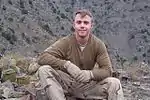3rd Special Forces Group (United States)
The 3rd Special Forces Group (Airborne) – abbreviated 3rd SFG(A) and often simply called 3rd Group – is an active duty United States Army Special Forces (SF) group which was active in the Vietnam Era (1963–69), inactivated, and then reactivated in 1990. 3rd Group—as it is sometime called—is designed to deploy and execute nine doctrinal missions: unconventional warfare, foreign internal defense, direct action, counter-insurgency, special reconnaissance, counter-terrorism, information operations, counterproliferation of weapon of mass destruction, and security force assistance.[2] The 3rd SFG(A) was primarily responsible for operations within the AFRICOM area of responsibility, as part of the Special Operations Command, Africa (SOCAFRICA). Its primary area of operations (AO) is now Africa as part of a 2015 SOCOM directive[3] but 3rd Group has also been involved in the Caribbean and the Greater Middle East. The 3rd SFG(A) has seen extensive action in the War on Terror and its members have distinguished themselves on the battlefield in Afghanistan.
| 3rd Special Forces Group (Airborne) | |
|---|---|
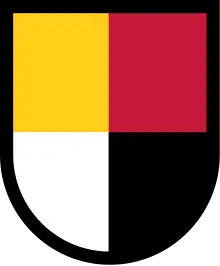 3rd Special Forces Group beret flash | |
| Active | 5 Dec 1963 – 1 Dec 1969 1 Jul 1990 – present |
| Country | |
| Branch | |
| Type | Special operations forces |
| Part of | |
| Garrison/HQ | Fort Bragg, North Carolina |
| Motto(s) | "De Oppresso Liber" |
| Engagements | Vietnam War |
| Insignia | |
| Former 3rd SFG(A) recognition bar, worn by non-special operations qualified soldiers—in lieu of a beret flash—from the 1960s to 1984[1] | |
| 1st Special Forces Command (Airborne) shoulder sleeve insignia, worn by all 1st SFC(A) units | .png.webp) |
U.S. Special Forces Groups | |
|---|---|
| Previous | Next |
| 1st Special Forces Group | 5th Special Forces Group |
History
1960s
3rd Group was first activated on 5 December 1963 at Fort Bragg, North Carolina. The four colors of the quadrants of 3rd Group's beret flash are derived from the flashes of the pre-existing SF units from which 3rd Group's members were initially drawn (hence its original motto: "From the Rest Comes the Best"). These colors are: yellow (1st SFG (A)), red (7th SFG (A)), black (5th SFG (A)), and white (Special Forces Training Group (A)). 3rd Group was originally oriented towards the Middle East and Africa during the 1960s. The unit trained the armed forces of Mali, Iraq, Ethiopia, the Congo, and Jordan – in addition to supporting the Gemini 6 and 7 space launches in 1965. 3rd Group also worked with the 5th SFG(A) in Vietnam. In 1966, 3rd Group transferred assumed control of the 403rd Army Security Agency Special Operations Detachment and the 19th PSYOP Company over to 5th Group.[4] With the "Vietnamization" of the conflict, the 3rd SFG(A) was inactivated in 1969 and its members were transferred back to the other Special Forces Groups. (One 3rd group officer who stayed on in South Vietnam—Major George W. Petrie—was first man on the ground in the Son Tay Raid (1970) and subsequently helped plan the Saigon evacuation (30 April 1975), becoming the last SF soldier to leave the country.)
1990s
_recon_Shok_Valley%252C_Afghanistan%252C_Dec._15%252C_2008.jpg.webp)
The 3rd Special Forces Group was reactivated in 1990. Its AO initially consisted of the Caribbean and West Africa. New group members were drawn primarily from the 5th SFG(A). At the outbreak of the Gulf War, 3rd Group's only functioning battalion (1st BN) was deployed to Dhahran, Saudi Arabia, for three months. Its A-Teams carried out reconnaissance and sabotage missions into denied areas of Iraq and Kuwait.[5] In February 1991, 3rd Group was tasked with the mission of securing and occupying the U.S. Embassy in Kuwait City.[6] The 2nd BN and 3rd BN of 3rd Group were reactivated in 1991 and 1992, respectively. 3rd Group also took part in the restoration of democracy in Haiti in 1994.[7] In the late '90s, 3rd Group helped train forces in Senegal, Uganda, Malawi, Mali, Ethiopia, and Trinidad and Tobago, among others.[8]
2000s
In the fall of 2000, the 3rd SFG(A) was involved in training and stabilization efforts in West Africa, dubbed "Operation Focus Relief" by the State Department; the training mission was geared towards combating the Revolutionary United Front.[8]
Since 9/11, the 3rd SFG(A) has been heavily involved in Afghanistan and Central Asia. Two of 3rd Group's battalions spend roughly six months out of every twelve deployed to Afghanistan as part of Combined Joint Special Operations Task Force – Afghanistan. In 2008, ten members of ODA 3336 were awarded Silver Stars for combat action during the Battle of Shok Valley. It was the largest set of citations for a single battle since the Vietnam War. After the citations were read then-commander of United States Army Special Operations Command, Lieutenant General John F. Mulholland, Jr., stated:[9]
As we have listened to these incredible tales, I am truly at a loss for words to do justice to what we have heard here, where do we get such men? … There is no finer fighting man on the face of the earth than the American soldier. And there is no finer American soldier than our Green Berets. If you saw what you heard today in a movie, you would shake your head and say, "That didn’t happen." But it does, every day.
Members of the 3rd SFG were involved in the 2003 invasion of Iraq, 26 Green berets from the group were given the task of securing a key crossroads near Debecka in Northern Iraq between the cities of Irbil and Kirkuk. If they succeeded, they would cut highway 2, preventing the Iraqi army moving north into Kurdistan and allow friendly forces to take the crucial Kirkuk oilfields. The 26 Green Berets were divided into two A-teams; ODA 391 and ODA 392, they were equipped with GMVs (Ground Mobility Vehicles)-modified Humvees with 50 caliber HMGs and Mark 19 Grenade launchers that could travel a thousand miles without resupply. the ODAs conducted battle training in Fort Bragg, North Carolina and Fort Pickett, Virginia between October and December 2002, On 8 March 2003, the ODAs flew from Pope Air Force Base to Romania and on 26 March 2003 they infiltrated northern Iraq via a MC-130 Combat Talon landing at Al-Sulaymaniya, some 60 miles east of Kirkuk. In their first few days in Iraq they participated in Operation Viking Hammer and then on 1 April 2003, they moved to Irbil and onto a staging area where they linked up with ODA 044, 10th SFG and their Peshmerga allies. On 4 April 2003, they were given a new mission, code-named Northern Safari, they were to seize the Debecka intersection until relieved by the 173rd Airborne Brigade's artillery component, On 5 April, they moved into position to seize the intersection and then on 6 April they ran into Iraqi army forces and the Battle of Debecka Pass ensued, resulting in American and Peshmerga victory. The Special Forces secured the crossroads and endured two days of Iraqi artillery fire and then into Kirkuk to secure the oil facilities to prevent their destruction by Iraqi forces.[10]
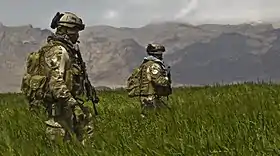
2010s
In October 2010, Staff Sergeant Robert James Miller was posthumously awarded the Medal of Honor. On 25 January 2008, Miller's team was ambushed during a combat reconnaissance patrol in Kunar Province near the Pakistan border. Miller's commander was seriously wounded within the first minutes of the attack. Wounded and under intense enemy fire, Miller held his ground and laid down suppressive fire on multiple insurgent positions, which allowed his wounded commander to be pulled out of the line of fire and his teammates to safely reach cover. Miller single-handedly eliminated several insurgents before succumbing to his wounds.
The 1st Battalion, 3rd SFG(A) were awarded the Canadian Commander-in-Chief Unit Commendation on 23 May 2012, for their actions during Operation Medusa in 2006. The ceremony was presided by Major-General Charles Cleveland, the commander of USASOC, and the award presented by CEFCOM Commander, Lieutenant-General Stuart Beare, on behalf of the Governor General of Canada. The 1st Battalion, 3rd SFG(A) is the first non-Canadian unit, and seventh overall, to receive this honour.[11] The citation read:
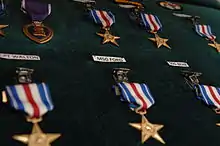
During August and September 2006, the 1st Battalion, 3rd Special Forces Group (Airborne), United States Army, displayed extraordinary heroism and outstanding combat ability while battling insurgents in support of a Canadian-led operation in Afghanistan. After completing their initial objectives, they willingly engaged a much larger force to secure the Canadian Battle Group’s flank and prevent the enemy from staging an effective counter-offensive. Outnumbered and facing a well-prepared enemy, they were relentless in their assault and eventually captured the position after days of intense fighting.
On 4 October 2017, 12 soldiers from the 3rd SFG and 30 Nigerien soldiers were ambushed in the Nigerien village of Tongo Tongo by the Islamic State in the Greater Sahara, which killed four Americans and four Nigeriens.[12]
Organization
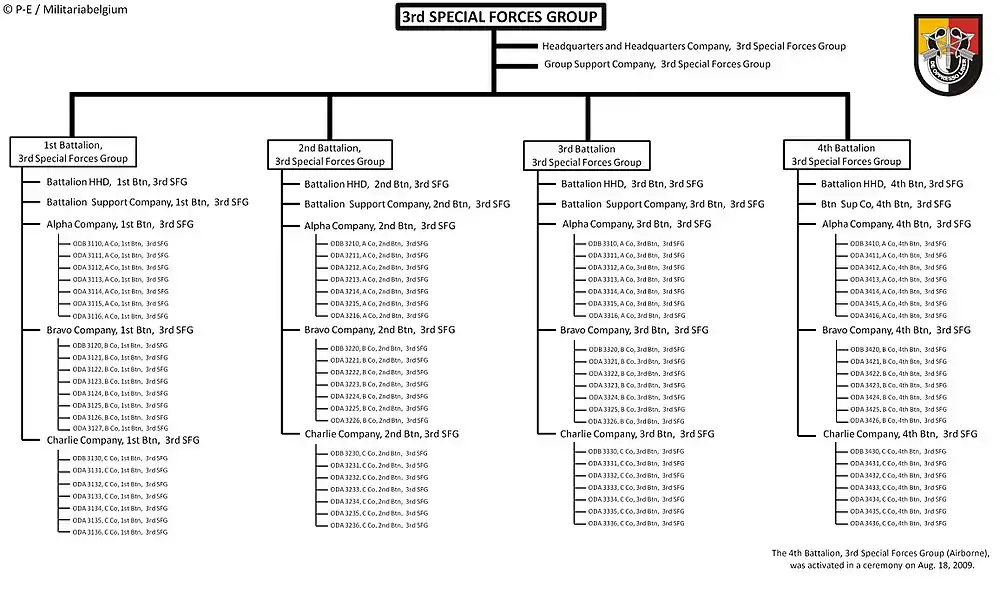
Notable officers and soldiers
- Staff Sergeant Robert James Miller, Medal of Honor recipient (October 14, 1983 - January 25, 2008)
- Captain Daniel W. Eggers, namesake of Camp Eggers, Afghanistan
- Captain Jeffrey MacDonald, MD, convicted in 1979 of three 1970 murders at Fort Bragg[13]
- Master Sergeant Stan Goff, former SF Ops sergeant and political activist
- Staff Sergeant Raymond Allen Davis, civilian CIA contractor in diplomatic row with Pakistan
- SFC Jason Everman, musician best known for playing in grunge bands Nirvana and Soundgarden before enlisting in 1994
- Staff Sergeant Ronald J. Shurer, Medal of Honor recipient (December 7, 1978 - May 14, 2020)
- Sergeant Major Matthew O. Williams, Medal of Honor recipient
- Staff Sergeant Dustin Michael Wright KIA 4 Oct 17, Africa
- Sergeant First Class Christopher Speer, Soldier's Medal recipient and Delta Force operator wounded in Khost Province, Afghanistan and later died at Ramstein Air Base, Germany. (September 9, 1973 - August 6, 2002)
References
- US Army Special Forces 1952–84, Bloomsbury Publishing, by Gordon L. Rottman, dated 20 September 2012, ISBN 9781782004462, last accessed 29 March 2019
- Army Special Operations Forces Fact Book 2018 Archived 19 October 2016 at the Wayback Machine, USASOC official website, dated 2018, last accessed 28 July 2019
- Naylor, Sean D. (27 August 2009). "SOCom directive announces major changes". Army Times. Retrieved 24 October 2014.
- Sutherland, Ian D.W. (1990), Special Forces of the United States Army: 1952–1982, San Jose, California: R. James Bender Publishing, pp 297–300.
- Smith, R. Jeffrey (4 March 1991), "U.S. Special Forces Carried Out Sabotage, Rescues Deep in Iraq", The Washington Post.
- Diaz, Tom (20 March 1991), "Special Forces Busy in Kuwait", The Washington Times, pg 1.
- Goff, Stan (2000), Hideous Dream: A Soldier's Memoir of the US Invasion of Haiti; Soft Skull Press.
- "3rd Special Forces Group (Airborne), 1st Special Forces Regiment". Global Security. Retrieved 24 October 2014.
- Patrick Jennings (20 May 2010). "Danger Close: ODA 3336 in the Shok Valley". Defense Media Network. Retrieved 5 March 2013.
- Cawthorne, Nigel, The Mammoth Book of Inside the Elite Forces, Robinson, 2008 ISBN 1845298217 ISBN 978-1845298210
- "U.S. Army unit receives Commander-in-Chief Unit Commendation for Operation MEDUSA". National Defence and the Canadian Armed Forces. 29 May 2012. Retrieved 24 October 2014.
- Hartmann, Margaret (19 October 2017). "What We Know About the Niger Attack That Left 4 U.S. Soldiers Dead". New York. Retrieved 19 October 2017.
- Transcript of Jeffrey McDonald’s Article 32 Investigation Hearing, 1970, Vol. 12., CPT Richard Thoesen, MSC: "I came to know Captain McDonald when he reported to the 3rd Special Forces Group. I was his sponsor… In the latter part of August… 1969…"
